Saturday, February 04, 2006
Billon antoninianus, Gallienus, Antioch, Göbl 1626c, cf T33
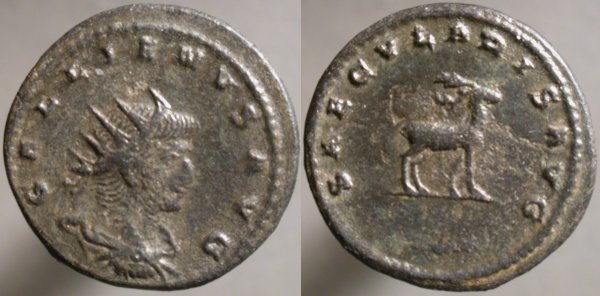
GALLIENVS AVG, Radiate draped cuirassed bust right | SAECVLARIS AVG, Stag standing right, branch in exergue.
Another coin of interest to me for its details: Göbl catalogs coins of this type with the misspelled legend SAECVLARHS AVG. On the examples I link, the details of how the stag stands vary.
Göbl does not catalog those the correctly spelled SAECVLARIS AVG but he does show one, with a left-facing draped cuirassed bust. My examples with this spelling have other busts, but all the reverses show the stag in very similar positions, with his head back. Initially I mistook them as all examples from the same die, but with more careful inspection I see that now two of them are from the same die, though the dies were very similar. The work of the same engraver, I think, cut perhaps within a few days of each other.
The Romans didn't leave written records of mint operations. The coins themselves must serve. It's interesting the Cohen, RIC, and the recently-published ERIC and Sear RCV columes list SAECVLARES AVG as the normal legend and that only Cohen notes a single example of SAECVLARHS AVG. SAECVLARES AVG may exist but SAECVLARHS AVG is the common one in the market and those that say otherwise are merely repeating what they've read and not doing original research.
Friday, February 03, 2006
Æ20, Ephesus in Ionia, Valerian, SNG Copenhagen 508var...
(EΦEC_IΩN T_VXN)
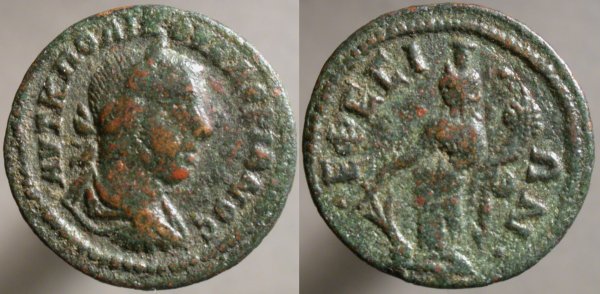
AYT K ΠO ΛIK OVAΛEPIANOC, Laureate draped bust right | ·EΦECI_ΩN·, Tyche standing left, holding rudder with right hand and cornucopia with left.
It's not that I avoid coins that are greatly different from those that I already have, but I do have a special appreciation for a group, each subtly different from the others. I have a near-superstitious belief that there's something significant to be learned from these coins, and a more rational sense that it'll be learned from the piddling details.

AYT K ΠO ΛIK OVAΛEPIANOC, Laureate draped bust right | ·EΦECI_ΩN·, Tyche standing left, holding rudder with right hand and cornucopia with left.
It's not that I avoid coins that are greatly different from those that I already have, but I do have a special appreciation for a group, each subtly different from the others. I have a near-superstitious belief that there's something significant to be learned from these coins, and a more rational sense that it'll be learned from the piddling details.
Thursday, February 02, 2006
Billon antoninianus, Gallienus, Siscia, Göbl 1411i
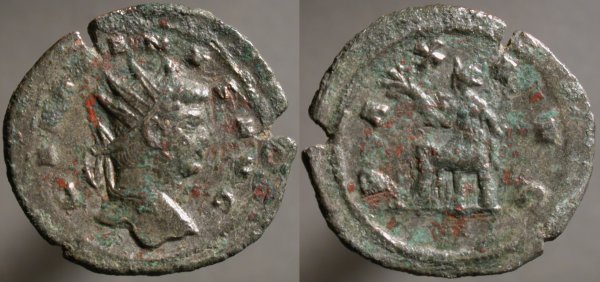
GALLIENVS AVG, Radiate head right | PAX AVG, Pax seated left holding branch in right hand and transverse scepter with left.
A little over a year ago I posted this coin, that prompted me to focus on collecting Gallienus, but didn't mention the doubts I've had about it. I suspect it may not be official mint product, but instead an ancient counterfeit.
With today's coin, a recent acquisition, I've got one that I feel more confident of and am able to silence a nagging little doubt that was always hovering.
Wednesday, February 01, 2006
Æ follis, Maximian, Aquileia, RIC 118
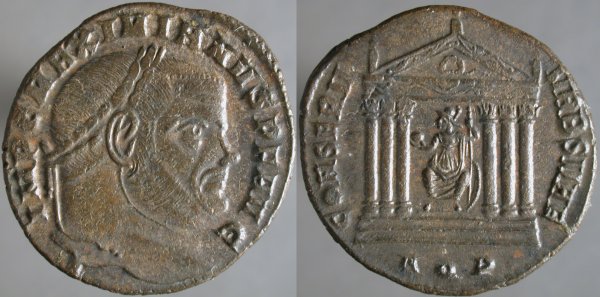
IMP C MAXIMIANVS P F AVG, Laureate head right | CONSERV VRB SVAE, Roma seated on shield, facing, in hexastyle temple, head left, holding orb in right hand and spear with left. AQP in exergue.
Two weeks ago I posted a coin of Diocletian. In 284, Diocletian selected his friend Marcus Aurelius Valerius Maximianus as co-emperor, Diocletian serving in the East and Maximian in the West. This situation continued until Diocletian, in failing health, chose to retire on May 1, 305. He also decided that Maximian would likewise retire that day.
By the end of October 306 Maximian had become convinced that a man of his qualities was needed by the empire and he unretired. This led to a crisis resolved only when Diocletian came to a council at Carnuntum, rejecting Maximian's urging to join him in unretirement and preferring instead to chew bubblegum and kick ass. Finding that bubblegum would not be invented for nearly 1600 years, he convinced Maximian to reretire.
Since retirement was not better the second time around, in 310 he attempted another unretirement. Being dead, Diocletian was no longer available to address the problem, so Maximian was either killed or chose to kill himself, depending on who's telling the tale.
Joviel's take.
This coin is from the period following the first unretirement. CONSERV VRB SVAE is Protector (or savior) of our city.
Tuesday, January 31, 2006
Æ tetradrachm, Alexandria, Gallienus, Emmett 3802(9 - ENATOV)

AVT K Π ΛIK ΓAΛΛIHNOC CEB, Laureate cuirassed bust right | L ENATOV, Eagle standing left, holding wreath. Transverse palm branch behind. Regnal year spelled out left.
I haven't been buying Alexandrian coins lately, in part because of an article by David Hendin (who's very experienced on ancient coins of Judea and environs) that mentioned a large batch of Alexandrian modern cast fakes that he'd seen.
As I've already bought a modern cast of these coins from another reputable dealer (promptly refunded, no trouble), a coin from a known collection, a decent pedigree, I'm a bit spooked.
The answer, I know, is that if I don't trust my own skills at spotting fakes then restrict my purchases to those from reputable, knowledgeable dealers.
(To be clear: this one's legit)
Monday, January 30, 2006
Billon antoninianus, Valerian II, Köln, Göbl 909e
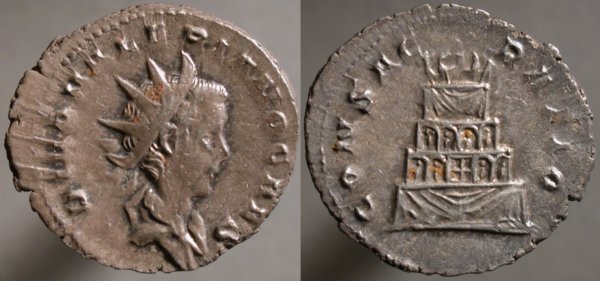
DIVO VALERIANO CAES, Radiate draped cuirassed bust right | CONSACRATIO, Crematorium topped with facing quadriga.
I looked once at the price, coughed, and jumped at it. The other posthumous coins of the sons of Gallienus feature either an eagle or a simpler shrine (or altar?) An ornate, quadriga-topped structure like this was more commonly seen in the 2nd century: this is the only such during this time, in the middle of the 3rd.
That it's unusual, and so cool, I just couldn't resist, past that first cough.
Sunday, January 29, 2006
Æ30, Perga in Pamphylia, Gallienus, SNG von Aulock 4731
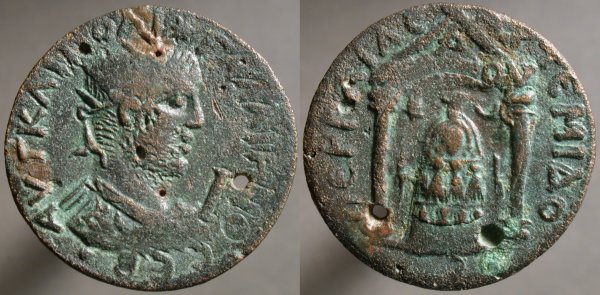
AVT KAI ΠOV ΓAΛΛIHNO CEB, Radiate draped bust right, star above, I before. | ΠEPΓAIAC [AP]TEMIΔOC, Distyle temple, simulacrum of Pergaean Artemis within, a torch to either side, star above left, crescent above right. A at top of pediment, ACVΛOV across it.
In Asia Minor, Artemis is often seen as in the photo here. The explanation of her odd ornaments as "bull testes" is one that I've not seen before.

